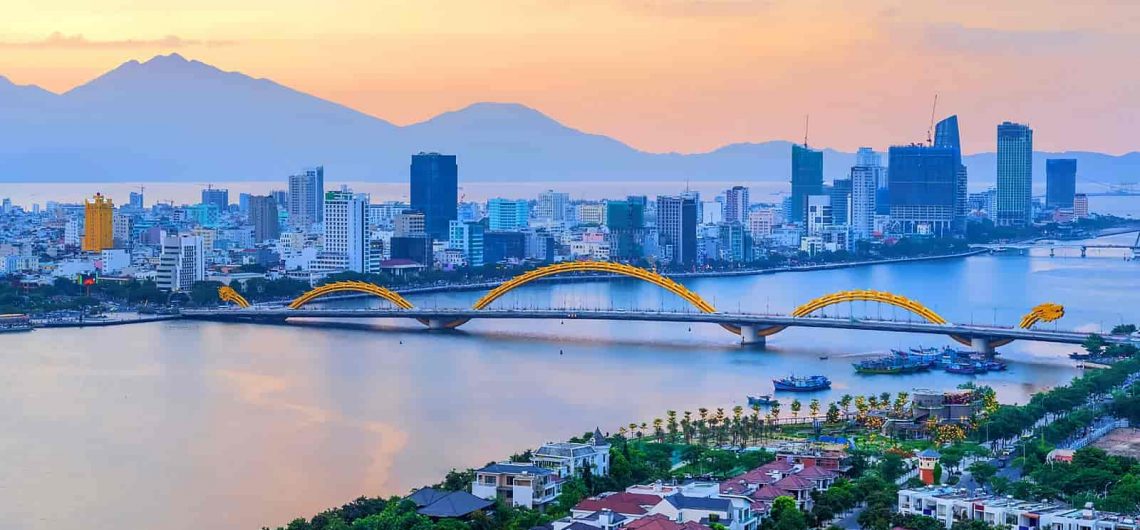Danang has undergone a rapid and astonishing transformation, as most people observe when returning to this place. The city of Danang is located in the central region of Vietnam, making it very convenient for people from both the North and the South to travel to. With its excellent location and the opportunity to explore both Hoi An and Hue, it annually attracts millions of domestic and international tourists for sightseeing and tourism.
In this introduction to Danang, DanangPrivateCar.com’s will provide a comprehensive overview of this place to help you better understand the city often referred to as the “Little Singapore.” You will gain a better understanding of why people often call Danang the most livable city in Vietnam.
An Overview of Danang City
Danang City covers a total area of over 1,000 square kilometers, consisting of six major districts: Hai Chau, Thanh Khe, Cam Le, Son Tra, Ngu Hanh Son, and Lien Chieu. These are the six largest districts in the city of Danang, and beyond the city limits, there are two suburban districts: Hoa Vang and the Hoang Sa island district. Currently, Danang has expanded with the addition of two more districts, Hoa Xuan and Hoa Quy, significantly increasing its total area.
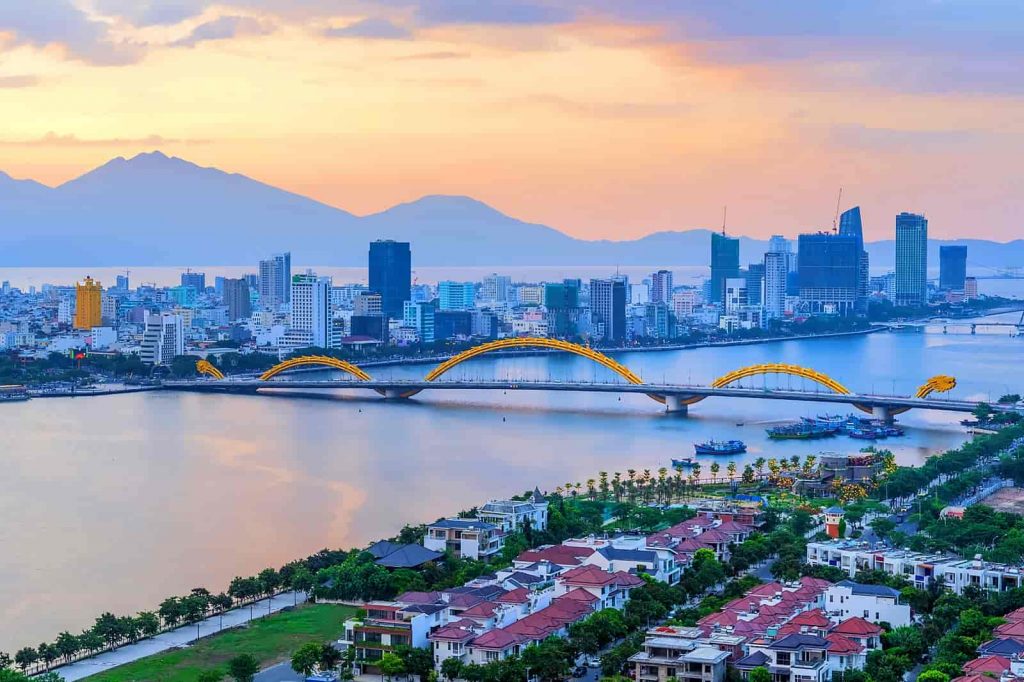
- Hai Chau District: Hai Chau district remains the top district in Danang and is the most economically developed area. Hai Chau district is the central hub of Danang for trade and business development and is often referred to as the central district.
- Son Tra and Ngu Hanh Son Districts: These are the two districts that attract the most tourists to Danang because of their proximity to My Khe Beach in Danang. This area boasts over a thousand hotels, large and small, making it the largest tourism center in Danang.
- Cam Le and Lien Chieu Districts: Compared to the three districts mentioned above, these two districts have seen slower development, primarily focusing on residential and traditional businesses in Danang.
- Hoa Vang District: Hoa Vang district is a suburban area located far from the city center of Danang, primarily engaged in agriculture.
With this overview of Danang City and its six districts, you now have a better understanding of this city. While Danang is much smaller in terms of land area compared to Hanoi and Ho Chi Minh City (Saigon), it is steadily developing and holds its position as a centrally administered city in Vietnam.
Geographic Location:
Danang City is located in the Central Region of the country, serving as a major transportation hub connecting the North and South through roadways, railways, seaways, and air routes. To the North, it borders with Thua Thien-Hue, to the West with Quang Nam, and to the East with the East Sea (South China Sea). Danang is considered the central hub of the Central Region, situated approximately 964 kilometers south of bustling Ho Chi Minh City and about 764 kilometers north of the capital, Hanoi.
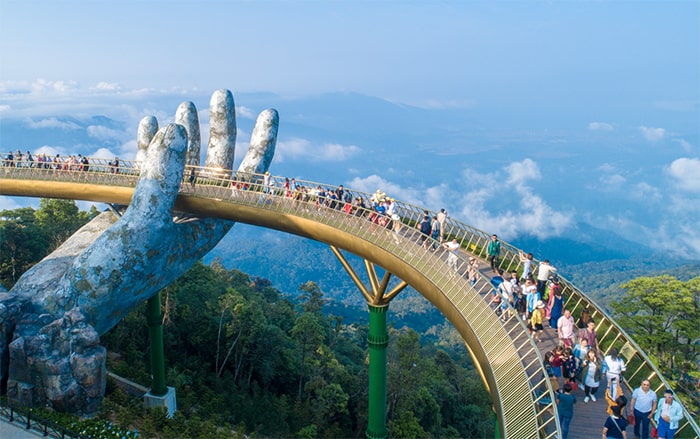
Furthermore, Danang also serves as a connecting point for three UNESCO World Heritage Sites: the Ancient Town of Hoi An, the Imperial City of Hue, and the My Son Sanctuary. A bit farther away lies the Phong Nha-Ke Bang National Park, a UNESCO Natural World Heritage Site, and the Paradise Cave. With a total area of 1,256.53 square kilometers, Danang is fortunate to have a diverse landscape, featuring high mountains, deep rivers, rolling hills, and beautiful coastal plains.
Diverse Landscapes:
Thanks to its advantageous geographical location and natural conditions, Danang is blessed with numerous beautiful beaches that stretch endlessly with fine white sand. Forbes magazine (USA) has voted Danang’s beaches as among the six most enchanting beaches on the planet. If you are a beach lover, you will undoubtedly be delighted to immerse yourself in the azure waters, frolic in the waves, or enjoy activities such as surfing, banana boat rides, jet skiing, and more.
Not only renowned for its beaches, Danang also boasts captivating landscapes, including the Son Tra Peninsula jutting out into the sea, the Hai Van Pass – known as the “majestic wonder,” and the famous Marble Mountains (Ngu Hanh Son), especially Ba Na Hills, which has become a hallmark of Danang tourism. There are many other attractions to explore as well.
Climate and Weather Characteristics:
Danang falls within the tropical monsoon climate zone, characterized by high temperatures and relatively low variability. Due to its strategic location, Danang experiences a transitional climate, influenced by both northern and southern climate patterns. However, it does not have distinct four seasons like the North; instead, it has two main seasons: the rainy season, which lasts from late August to December, and the dry season, which spans from January to July. Throughout the year, the temperature remains relatively stable, ranging from 25 to 26 degrees Celsius, with minimal variation between months.
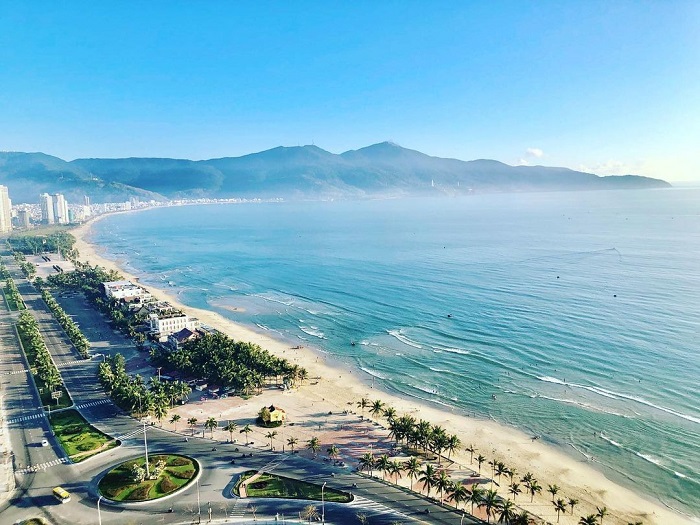
During the dry season, the average temperature is 25.7 degrees Celsius, occasionally experiencing brief periods of cold air but quickly returning to normal. Humidity is low, rainfall is minimal, and the weather tends to be warm due to the influence of Laotian winds. Conversely, the rainy season sees more precipitation, but temperatures remain relatively moderate, averaging around 25.5 degrees Celsius. However, thunderstorms and typhoons may occur. When planning a trip to Danang, consider these climate factors to choose a suitable time to visit.
If you are looking for airport transfer services in Da Nang, book a private car service from Da Nang Airport to Hoi An with DanangPrivateCar.com’s quickly.
Introduction to the History, People, Transportation, and Weather of Danang.
History and Development:
In the 16th century, when Hoi An was the bustling number one trading port in Southeast Asia, Danang also played a vital role in the transshipment of goods and was the largest shipbuilding center in the country. After a few years of rapid development, Danang surpassed Hoi An, becoming the leading trading port for commerce with countries worldwide.
In 1835, during the reign of King Minh Mang, he ordered all foreign merchant ships to anchor only at the Han River Port while forbidding trade at other seaports. This decision officially established Danang as the largest and most prosperous trading port in the Central Region.

Formerly, Quang Nam and Danang were part of the same province but later separated into two distinct provinces. Upon separation, Danang experienced remarkable development, attracting significant domestic and international investments before transforming into the largest city in the Central Region under central government jurisdiction today. During the French colonization in 1889, Danang was detached from Quang Nam, coming under direct rule by the French Indochina authorities.
Danang was officially returned to the rule of King Bao Dai’s government in 1950. However, in 1965, during the Vietnam War, American troops arrived in Danang. The war caused significant destruction in Danang until the nation achieved peace in 1975, when Danang began its process of recovery from the heavy toll of the conflict.
In 1996, Danang, with impressive achievements in its development, was officially recognized as a centrally administered city at the forefront of Central Vietnam.
The People of Danang:
Kindness, honesty, approachability – these are the hallmarks of the people of Danang. People often add that Danang locals are peaceful, hospitable, and enthusiastic. Let’s delve into the characteristics of the people of Danang:
- Peaceful: The people of Danang lead tranquil and unhurried lives. Despite the hustle and bustle elsewhere, people here go about their business diligently and quietly. They pursue work they are passionate about, prioritize rest, and do not overly chase after material gains. Unlike many places, you will rarely encounter price gouging when dining or shopping in Danang. The cultural identity of the people of Danang remains intact to this day, and visitors often wonder why life here is so serene.
- Hospitable: Being gentle and honest is not just a characteristic; it is the distinctive trademark of Danang’s residents. Tourists visiting Danang are always warmly received, and there is no distinction between them and “local guests,” as is often the case in other major tourist destinations across the country. Whether it’s the luxurious 4-5-star hotels or smaller accommodations, a high level of professionalism and hospitality is consistently exhibited. Friendly smiles, polite gestures, and respectful ways of addressing people, like “cô chú” (aunt and uncle) or “con” (child), warm the hearts of all who come here. This is why visiting Danang feels so familiar and welcoming.
- Enthusiastic: If you come here and sense the enthusiasm of Danang’s people, it’s because they often prioritize the well-being of others over their own interests, sometimes to their own disadvantage. In Danang, you don’t need Google Maps because you’ll rarely get “lost.” People in Danang are so eager to help that if you ask for directions and don’t quite understand, they’ll guide you to your destination without expecting any reward in return. Don’t be surprised if you receive a fine for traffic violations in Danang, as there are traffic cameras at major intersections and thoroughfares. Therefore, it’s essential to obey traffic laws while traveling in Danang.
Transportation in Danang:
If you’ve experienced the notorious traffic jams in Hanoi or Ho Chi Minh City, you’ll find Danang’s traffic refreshingly smooth. People follow traffic rules diligently and responsibly. It’s rare to see someone on the road without a helmet, speeding recklessly, or running red lights.
Danang’s streets are ranked among the top in the country for traffic signal adherence. At every intersection and crossroads, you’ll encounter red lights and may wonder why there are so many green and red lights. Nevertheless, people obey the rules admirably, and there is no hasty crossing of red lights endangering others.
Danang’s streets, including its intersections and crossroads, are equipped with surveillance cameras for traffic law enforcement. If you violate traffic rules, you may receive a fine notice at your doorstep. So, be mindful of traffic laws while traveling in Danang.
If you are looking for a means of travel to Da Nang, DanangPrivateCar.com’s takes pride in being a provider of private car services with experienced drivers in Da Nang. With a team of drivers who have basic English language skills and are 100% local, we will ensure that you have the most comfortable, enjoyable, and safe journey
Weather and Climate in Danang:
Danang enjoys a pleasant climate due to its coastal location. It falls within the tropical monsoon climate zone, characterized by high temperatures with minimal variations.
Danang experiences two distinct seasons:
- Dry Season: Lasting from April to September, this season offers little rainfall and higher temperatures, ideal for beach activities and sightseeing.
- Rainy Season: Typically occurring from October to February, this season brings more precipitation, though temperatures remain moderate.
Despite the seasonal variations, Danang is a year-round tourist destination, as its weather and climate are not extreme. The sunny season is not excessively hot, and the rainy season is not excessively cold. This is why Danang is often referred to as Vietnam’s tourism paradise.
Introduction to Danang: Deciphering the Reasons for its Reputation as the “City Worth Living In.”
Why is Danang referred to as the “City Worth Living In” across the country? Here is a compilation of the reasons behind this designation:
- Every year, Danang continues to sprout new and innovative constructions.
- This is the place with famous bridges spanning the Han River, especially featuring the Dragon Bridge that breathes fire.
- This is a place where tourism and commerce thrive without ever overcharging.
- This is a place with a city-wide free Wi-Fi system.
- This is where My Khe Beach ranks among the top 6 most beautiful and alluring beaches on the planet.
- This is where you find the largest system of free public restrooms in the country.
- This is a place with kind, friendly, and hospitable people.
- This is where there’s a cancer treatment hospital that offers free care to the people of Danang.
- This is where you can savor numerous specialties and enjoy delicious and affordable cuisine.
- This is a place where theft, robbery, and begging are extremely rare.
- This is a place with a comprehensive security camera system throughout the city, making you feel very safe.
- This is a place with many of the most famous tourist attractions in the country.
These are just some of the reasons why people consider Danang the most livable city in Vietnam. There are still many aspects that contribute to Danang’s current reputation. You should come and explore for yourself to see that Danang never disappoints. It’s from these impressive experiences that anyone who has visited this coastal city wants to come back for another visit.
Introduction to Danang – Easiest Modes of Transportation.
From major cities across the country, there are flight routes to the beautiful city of Danang. Depending on your budget and flight duration, you can choose from airlines like Vietnam Airlines, Vietjet Air, and Bamboo Airways, all of which operate daily flights to Danang. Particularly, Vietjet Air often offers promotional programs, such as 0 VND tickets. Airfare prices can range from 600,000 VND to 2,500,000 VND depending on the airline, with a travel time of approximately 1 hour and 30 minutes.
As for transportation within Danang, there are numerous options, and booking a ride is quite easy. You can use ride-sharing services like Grab Bike/Grab Car or arrange shuttle services if you need to travel within the city or to suburban attractions like Ba Na Hills, Marble Mountains, Hue, or Hoi An.
Introduction to Famous Tourist Attractions in Danang.
Danang is consistently hailed as the most livable city in Vietnam and boasts captivating attractions that draw travelers from all around the world. With its pristine and lengthy coastline, renowned tourist spots with global recognition, Danang has become the top destination for everyone.
Below, I will introduce some of the most famous tourist attractions in Danang that people find extremely fascinating and intriguing:
Ba Na Hills
Known as the paradise in Danang, Ba Na Hills will leave you in awe with its ultramodern Western-style architecture. Situated on Mount Chua at an altitude of 1,489 meters above sea level, about 25 kilometers from the city center in Hoa Ninh, Hoa Vang, Danang. Ba Na Hills gained immense popularity worldwide, especially after the Golden Bridge was inaugurated. The Golden Bridge captivated the internet, making Ba Na Hills a must-visit destination for travelers. Many have visited this magnificent structure multiple times to witness its grandeur.

Son Tra Peninsula
This peninsula juts out into the sea and is known as the “green lungs” of Danang. Son Tra Peninsula is incredibly beautiful, with diverse natural landscapes, the famous Linh Ung Pagoda, a rich marine ecosystem, and diverse coral reefs. The road leading to Son Tra Peninsula from the city center winds along the coastline, embracing the peninsula’s edge.
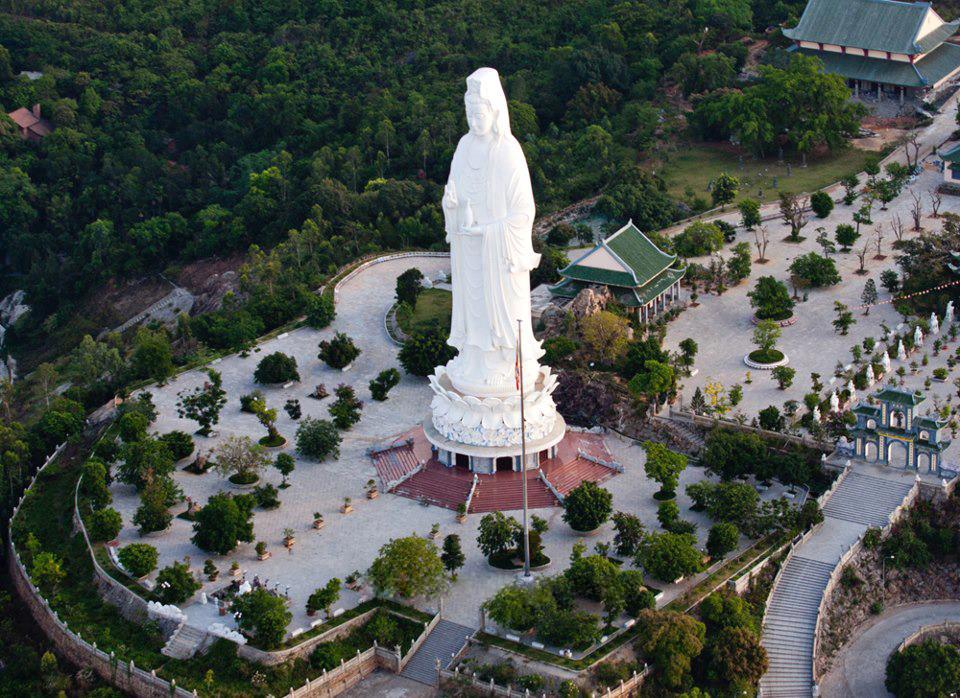
Hoi An Ancient Town
Recognized as the most charming city in the world in 2009, Hoi An attracts tens of thousands of international tourists every year. Preserving its ancient cultural heritage and being a UNESCO World Heritage Site, Hoi An’s Old Quarter exudes a timeless charm with its centuries-old yellow-walled houses and narrow winding streets, providing a peaceful escape from the hustle and bustle of urban life.
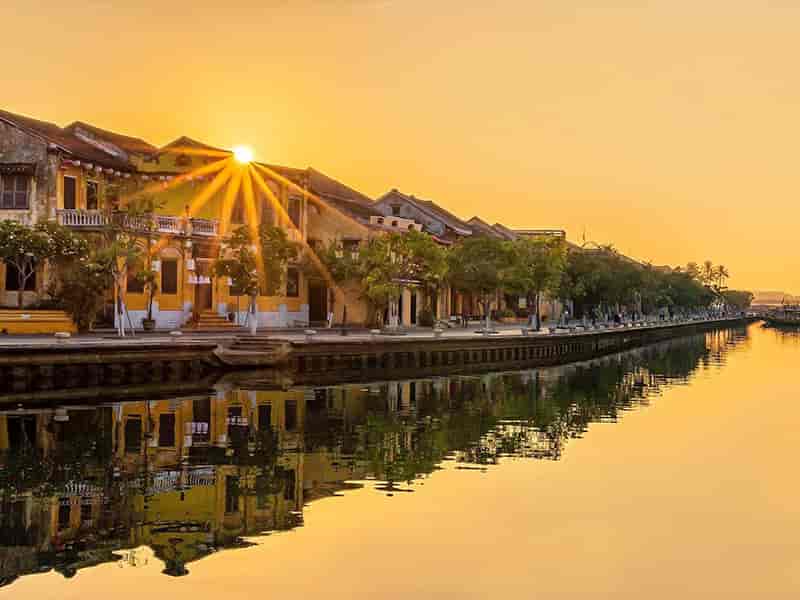
Marble Mountains
The Marble Mountains are a cluster of five limestone and marble hills with cave temples, pagodas, and panoramic views of Danang’s coastline. The mountains are also known for their stone-cutting and sculpture industries.
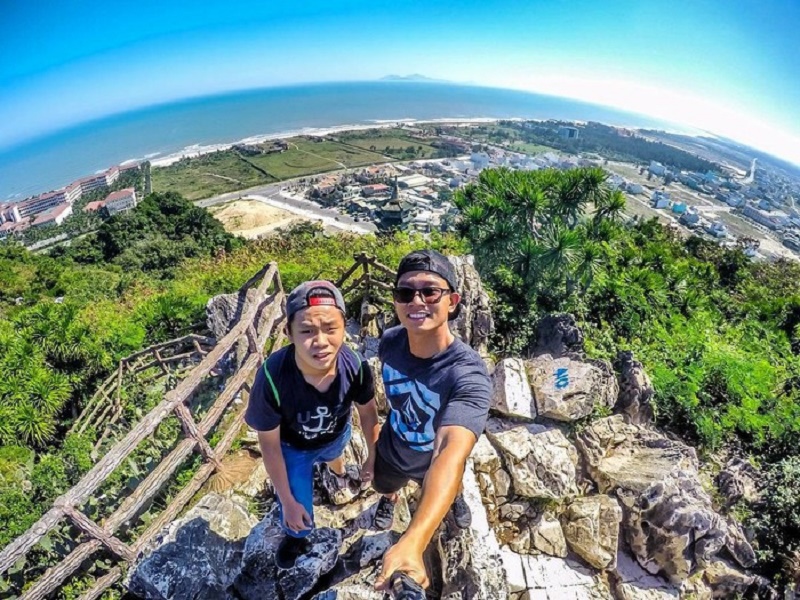
My Khe Beach
My Khe Beach is a stunning stretch of golden sand and crystal-clear waters, often ranked among the top six most beautiful and alluring beaches on the planet. It offers excellent swimming and water sports opportunities.
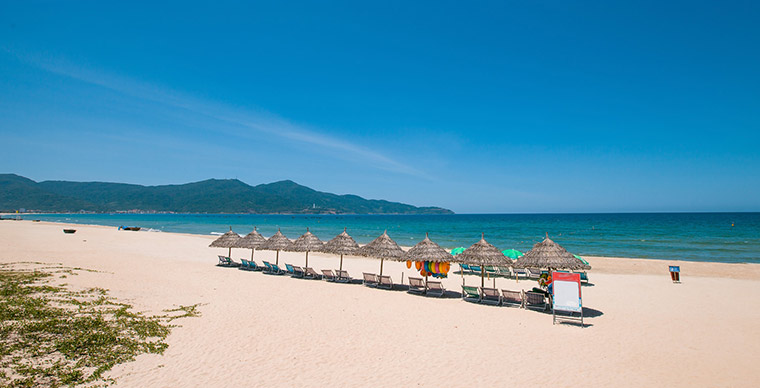
Linh Ung Pagoda
Located within the Son Tra Peninsula, Linh Ung Pagoda is famous for its giant Lady Buddha statue overlooking the sea, creating a mesmerizing and serene atmosphere.
Dragon Bridge
The Dragon Bridge is an iconic symbol of Danang. It is famous for its dragon-shaped design and its habit of spewing fire and water during weekend nights.
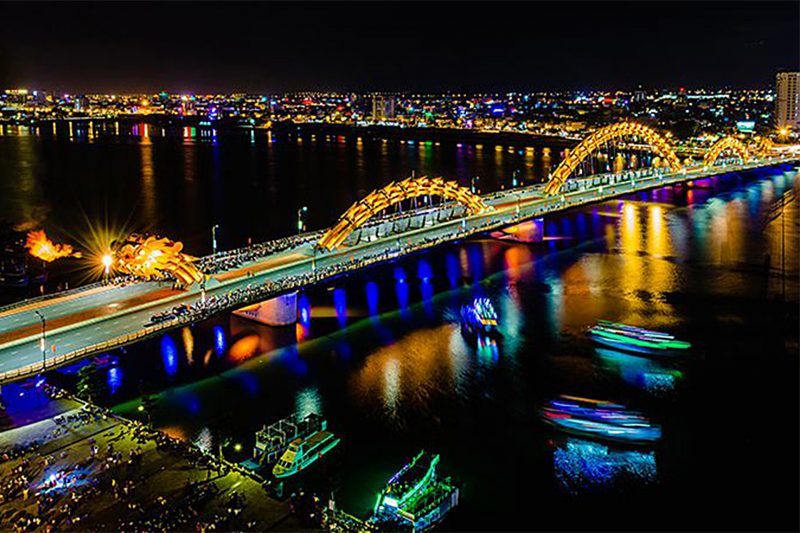
Asia Park
Asia Park is an amusement park located in the city center, offering a wide range of rides and games, including the Sun Wheel, the largest ferris wheel in Southeast Asia. The park provides a fantastic view of Danang at night.
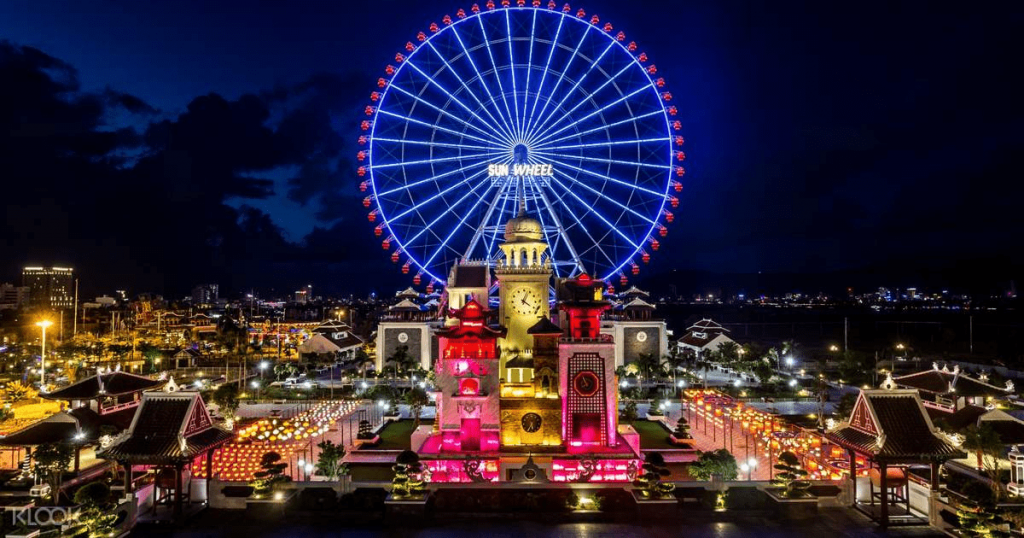
Apart from the mentioned tourist spots, there are many more famous attractions in Danang that captivate travelers. To explore in-depth, you can refer to my comprehensive travel guide to Danang, which offers authentic insights based on my own experiences visiting the city.
Introduction to Da Nang’s culinary delights.
Apart from the ever-popular tourist destinations in Da Nang, you can also explore the local specialties and culinary delights that carry the distinct flavors of the Central region, leaving you in awe and delight with every taste.
To energize yourself for the exploration of Da Nang’s famous tourist spots, it’s also essential to discover some affordable and delicious eateries here. I’ll list the best dishes in Da Nang that you won’t be able to resist:
- Breakfast: Mi Quang, Cao Lau, Bun Bo Hue, Bun cha ca, Banh Canh, Bun Mam, and more.
- Lunch and Dinner: Chicken rice, Com Nieu, Rice with clams, Broken rice, Rolled pork with rice paper, and the standout, Da Nang’s Seafood.
In addition to the fantastic eateries, Da Nang’s renowned local specialties also make great souvenirs, such as Da Nang beef sausage, Fermented pork, Sun-dried squid, Nam O fish sauce, and various dried specialties.
Introduction to Da Nang – the shopping paradise of Central Vietnam.
There are few cities where shopping venues abound like they do in Danang. If you’re looking to buy local specialties or indulge in culinary delights, Danang has it all. Almost every traveler who visits this vibrant city is advised to shop at Con Market, Han Market, both conveniently located in the city center, right on the main arteries. Here, visitors will quickly be drawn into a world of culinary delights and shopping, as just about any food or specialty item can be found at your fingertips.
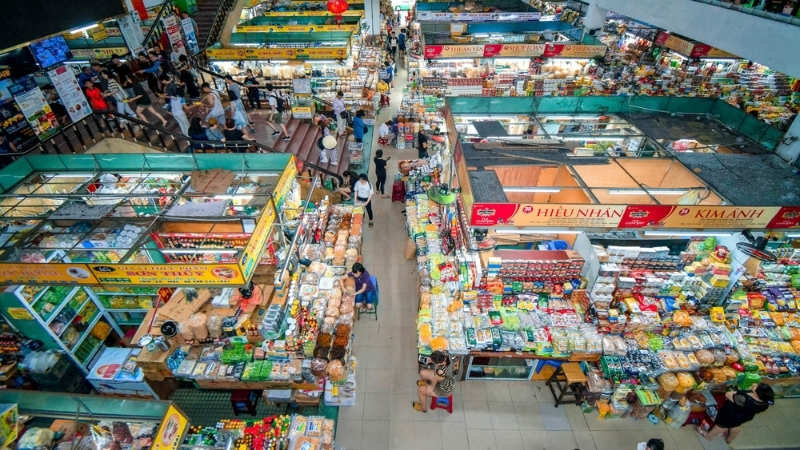
Introduction to Da Nang and future prospects.
Da Nang is experiencing continuous and robust economic growth, with a strong emphasis on tourism. It is estimated that in 2023 and the coming years, the city aims to attract millions of tourists to explore and enjoy what Da Nang has to offer.
With the increasing number of tourists in Da Nang, there is a significant expansion and investment in infrastructure, security, and resort development. It is hoped that Da Nang will lead the nation in terms of tourism and maintain its reputation as “Vietnam’s Paradise of Tourism.”

